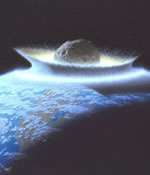
Image credit: NASA
A team of researchers from Louisiana State University have uncovered a connection between a meteor strike and a mass extinction that happened 380 million years ago called the middle Devonian event. It happened at a time when small plants, wingless insects and spiders inhabited the land, and everything else lived in the sea – 40% of all life disappeared from the fossil records. They found evidence of the strike by measuring the magnetic signature of layers of rock. When a large asteroid hits the Earth, it distributes a layer of dust around the entire planet – if a strata of rock has the same magnetic signature in different parts of planet, it’s evidence of a strike.
It’s the stuff of science fiction movies. Bruce Willis, by a mighty effort, saving the world from extinction by a huge meteor.
But Bruce Willis won’t do it, and in our current state of readiness, neither will anyone else. That is why LSU geophysicist Brooks Ellwood is plumbing the geologic record, trying to correlate known mass extinctions to meteor strikes.
“When we think about the human race and life in general, what do we worry about? We worry about nuclear holocaust and major glaciation. Then we worry about the giant chunks of rock that fly past Earth all the time,” Ellwood said.
“We can’t see them till they’re here, we can’t stop one, so the question is, how often do they hit the Earth and cause major mass extinctions? Are extinctions often caused by impacts? If so, we want to be sure we are prepared.”
Ellwood and four other researchers have just published an article in the journal Science in which they tie an early mass extinction to a meteor strike. This extinction happened 380 million years ago in what is called the middle Devonian. It was a time when only small plants, wingless insects and spiders inhabited the land and everything else lived in the sea. About 40 percent of all species disappeared from the fossil record at this time.
The extinction has been known to geologists for a long time but this is the first time it has been tied to a meteor strike. This is also the oldest known impact that has been tied to a mass extinction.
Ellwood is quick to point out that because the extinction and the meteor strike happened at the same time does not prove the impact caused the extinction — but it certainly suggests it.
One of the great difficulties in determining whether an extinction happened on a global scale, or was a local event caused by a volcano or some other terrestrial force, is identifying the same strata of rock at different locations on the globe. Finding a layer of earth in Colorado, for example, and finding that same layer in Australia is no simple task.
“The same layer of earth is exposed to different conditions in different parts of the world,” Ellwood said. “Weathering, upheavals, volcanos, earthquakes and flooding all confuse the geologic record, making it incomplete and open to interpretation.”
The layers can also be extremely thin, he said, showing a picture of the location of his latest research. The layer he was looking at — near the top of a barren plateau in the Anti Atlas desert near Rissani in Morocco — was about the thickness of a felt-tipped marker and only distinguishable from the soil around it by its reddish color.
What is unique about Ellwood’s work, however, is the means he uses to identify the different layers in the geologic record: induced magnetism.
“Everything is magnetic,” he said. “If I put your finger in a magnetic coil and turn it on, your finger will be magnetized.” Ellwood uses this phenomenon to take “magnetic signatures” of geologic samples. The magnetic signature of a layer of earth will be the same anywhere in the world, making it relatively easy to identify strata, if they can be found. These signatures also make it easy to identify meteor strikes. “The magnetic pattern associated with an impact layer is often distinctive, making it easier to find in a thick sequence of strata,” he said.
Working with LSU graduate students Steve Benoist and Chris Wheeler; structural geologist Ahmed El Hassani of the University of Rabat, Morocco; and Devonian biostratigrapher Rex Crick of the University of Texas at Arlington, Ellwood was able to find high concentrations of shocked quartz, microscopic spherules and microcrysts in this layer, sure signs of a meteor impact. Benoist is a paleontologist and Wheeler is an isotope geochemist; both have since moved on.
The past 550 million years are divided up by geologists into about 90 “stages.” Each stage is distinguished from another by a change in the fossil record. To date, only four of these stages show strong evidence of a meteor strike, Ellwood’s discovery being the latest, as well as the oldest. The most recent, best known extinction is the K-T boundary at which the dinosaurs died out, about 65 million years ago. There have been five major mass extinctions and many smaller ones since then.
“We know that meteors have struck the Earth hundreds of times,” Ellwood said. “If I had to guess, I would say that once every 5 million years a meteor big enough to cause a mass extinction hits the Earth.
“We could protect ourselves if we wanted. We went to the moon, we can figure out how to destroy or deflect a meteor. All it takes is the political will — and an awareness of the threat.”
The work of Ellwood and his team, published in the prestigious journal Science, is a step in that direction.
Original Source: LSU News Release

You made some good points there. I did a search on the topic and found most people will agree with your blog.